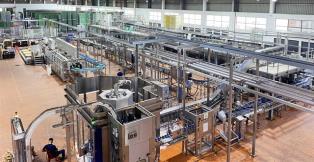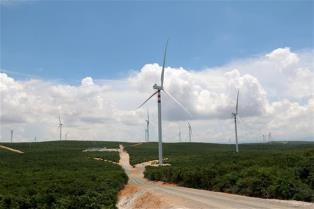Amid multiple global challenges, Việt Nam’s 7.52 per cent GDP growth stands out as a bright spot, demonstrating the economy’s enduring resilience.
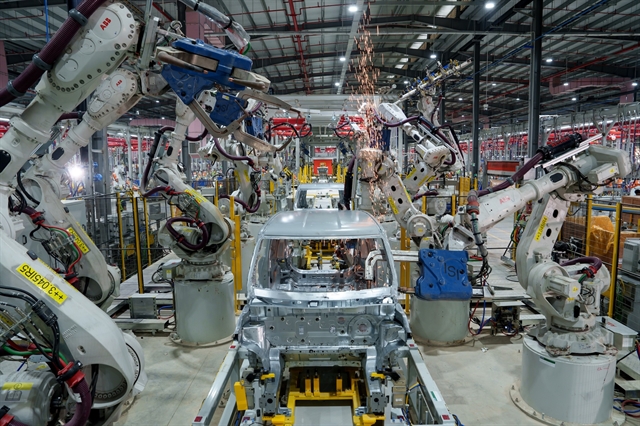
Việt Nam’s GDP grew by 7.52 per cent in the first half of 2025 compared to the same period last year, the highest H1 growth rate recorded in 14 years, according to the Ministry of Finance’s National Statistics Office (NSO).
In addition to robust GDP growth, the economy also set records across several key economic indicators during the first six months of the year, the office said.
General Statistics Office Director Nguyễn Thị Hương said the global situation in the first half of 2025 remained complex and difficult to forecast, especially due to US tariff policies and responses from other countries.
Rising geopolitical instability and escalating military conflicts across several nations had adversely affected global economic growth. Consequently, many international organisations had downgraded their global growth forecasts for 2025 from earlier projections, Hương said.
Amid these challenges, Việt Nam’s 7.52 per cent GDP growth stood out as a bright spot, demonstrating the economy’s enduring resilience.
Speaking at a press conference in Hà Nội on July 5, Hương said that the strong economic performance reflected the determination, coordinated efforts, and decisive actions of the entire political system in managing and advancing socio-economic development amid ongoing regional and global uncertainties.
Dr Võ Trí Thành, an economist,attributed the optimistic economic results in the first half of the year to unprecedented administrative reforms as a key driver.
Thành told thanhnien.vn that the Vietnamese economy had never undergone such drastic and wide-reaching administrative reform as in recent months.
"This is a revolution, and initial growth figures already reflect remarkable outcomes," he said.
He cited the nearly 15 per cent growth in administrative support services over the past six months as a clear indicator of this breakthrough.
“Growth in the field of administrative reform at this scale is rare. Reorganisation of the state management apparatus has significantly contributed to the economy’s strong performance," he added.
Economist Trần Anh Tùng at Hồ Chí Minh City University of Economics and Finance said GDP grew strongly in H1 thanks to three aspects - FDI, exports and the tourism and service sector.
"Of these three factors, FDI and exports are the main driving force thanks to the spillover effect on production and labour attraction, while tourism is a supporting factor," he said.
Tùng outlined four reasons affecting the sudden growth of the above pillars. First, the monetary policy of the State Bank of Vietnam since the beginning of the year had been effective in keeping the exchange rate stable and controlling inflation reasonably, thereby strengthening consumer confidence and keeping purchasing power from being eroded.
The second key driver, he said, was the structural shift in production towards higher value-added manufacturing and processing industries, along with improved localisation rates - both of which had significantly boosted overall GDP.
The third factor was the accelerated disbursement of public investment, which reached approximately 43 per cent of the annual plan. This provided a strong push to GDP growth through the advancement of major transport infrastructure projects.
Finally, new-generation free trade agreements continued to deliver positive results, with many businesses leveraging tariff incentives to expand exports and attract fresh investment.
"The combination of these factors has laid a solid foundation for the economy to exceed earlier growth forecasts," Tùng added.
Strong momentum
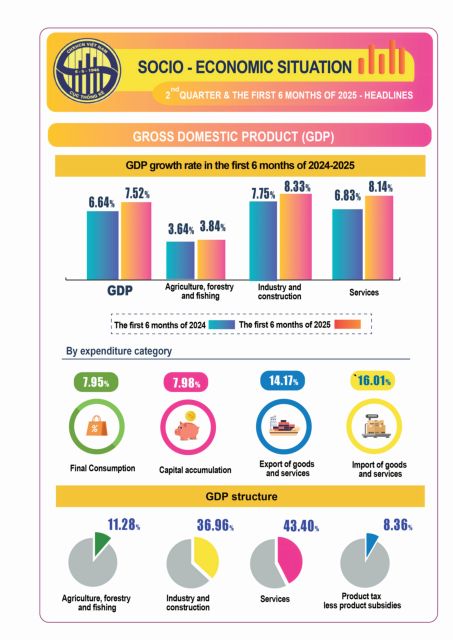
According to the NSO, the strong growth in the second quarter played a crucial role in the overall economic success of the first half of 2025.
In the second quarter, GDP grew by an estimated 7.96 per cent year-on-year, marking the second-highest Q2 growth rate between 2020 and 2025, just behind the 8.56 per cent recorded in Q2 2022.
This performance stands out compared to previous years in the period, which saw growth rates of 0.34 per cent in 2020, 6.55 per cent in 2021, 4.34 per cent in 2023, and 7.25 per cent in 2024.
In terms of sectoral contributions to GDP growth in the first half of 2025, the industry and construction sector expanded by 8.33 per cent, accounting for 42.2 per cent of the overall increase.
The agriculture, forestry, and fisheries sector grew by 3.84 per cent, contributing 5.59 per cent, while the services sector rose by 8.14 per cent, making the largest contribution at 52.21 per cent.
The industrial and construction sector showed strong momentum, with the industrial production index rising by 8.07 per cent compared to the same period last year. The processing and manufacturing industry continued to be the key growth driver, recording a robust 10.11 per cent increase.
The services sector continued to benefit from vibrant foreign trade, transport, and tourism activities, driven by rising regional and global demand. Its 8.14 per cent growth marked the highest mid-year increase for the sector since 2011.
Agriculture maintained stable growth, with the sector's added value up 3.51 per cent year-on-year, contributing 0.29 percentage points to overall economic growth.
In the first six months of 2025, total import-export turnover exceeded US$432 billion, up 16.1 per cent year-on-year. Exports rose by 14.4 per cent, and imports by 17.9 per cent. The trade surplus reached $7.63 billion.
Regarding business activity, the country saw 91,200 newly established enterprises in the first half of the year with registered capital totalling approximately $32.3 billion and over 591,000 registered workers. These figures represent increases of 12 per cent in the number of enterprises, 10 per cent in registered capital, and 14 per cent in labour compared to the same period last year.
The average registered capital per newly established business in H1 2025 was approximately $356,000, down 1.7 per cent from H1 2024.
Additionally, over 61,500 enterprises resumed operations, a 57.2 per cent increase over the same period in 2024. This brought the total number of new and resumed businesses in the first six months to more than 152,700, a 26.5 per cent increase year-on-year.
On average, nearly 25,500 businesses were either newly established or resumed operations each month.
The NSO also reported that the consumer price index for Q2 2025 rose by 3.31 per cent year-on-year. The average index for the first half of the year increased by 3.27 per cent, while core inflation rose by 3.16 per cent.
Foreign investors registered $21.5 billion in investments in Việt Nam during the first half of this year, marking a 33 per cent increase compared to the same period last year.
At the same time, foreign investment disbursement continued its upward trend in the period, reaching an estimated $11.7 billion, an increase of 8.1 per cent year-on-year and the highest first-half growth recorded in the past five years.
Pushing towards annual targets
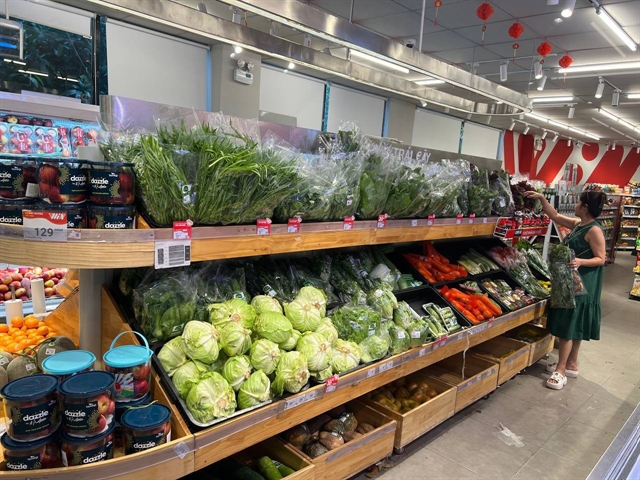
The NSO reported that Việt Nam’s economy and society continue to face numerous challenges. With the country’s high level of economic openness, it remains susceptible to unpredictable developments in the global economy, geopolitics, public health, and natural disasters.
To meet the ambitious growth target of over 8 per cent for the year, coordinated efforts across all levels of the Government, the business sector, and the public are crucial.
The office stressed the need for enhanced monitoring and forecasting, flexible and timely policy responses, and a steadfast commitment to fostering growth. At the same time, it was essential to maintain macroeconomic stability and keep inflation under control.
Economist Thành said that Việt Nam’s strong growth momentum entering the third quarter would be a key advantage for the second half of 2025. However, he cautioned that achieving the full-year target of 8 per cent growth would face significant challenges.
"Việt Nam is a highly open economy, so any fluctuations in the global market will directly impact the country," he said. "With ongoing global uncertainty, geopolitical conflicts and changing tariff policies, trade and investment will be affected."
Domestically, the crucial factor would be the commitment to public investment, as disbursement rates in many localities remained below average, which could dampen the overall economic outlook.
He also stressed the need to sustain export growth, attract FDI, accelerate infrastructure development and speed up administrative reforms to lure investment.
Huỳnh Thanh Điền, PhD, a lecturer at Nguyễn Tất Thành University in HCM City, also expressed optimism about Việt Nam’s ability to sustain its key economic growth drivers in the coming period. He noted that despite global economic fluctuations, Việt Nam continued to demonstrate a stable and attractive investment environment.
"Even in the face of external pressures such as increased tariffs, the Government’s strategic and flexible policy responses have helped maintain investor confidence. This is reflected in the strong rise in newly registered foreign investment in the early months of the year," Điền said.
He said he believed that this advantage would likely be further leveraged in the second half of the year.
Another positive factor was the continued strong performance of the service and tourism sectors. The latter half of the year would present several favourable conditions to boost tourism, shopping and consumer spending, which would further stimulate demand for services.
These elements were expected to complement one another and collectively support GDP growth in line with projections, helping to achieve the annual target of 8 per cent. VNS
- Tags
- GDP
- economic growth
- FDI
- Vietnam




